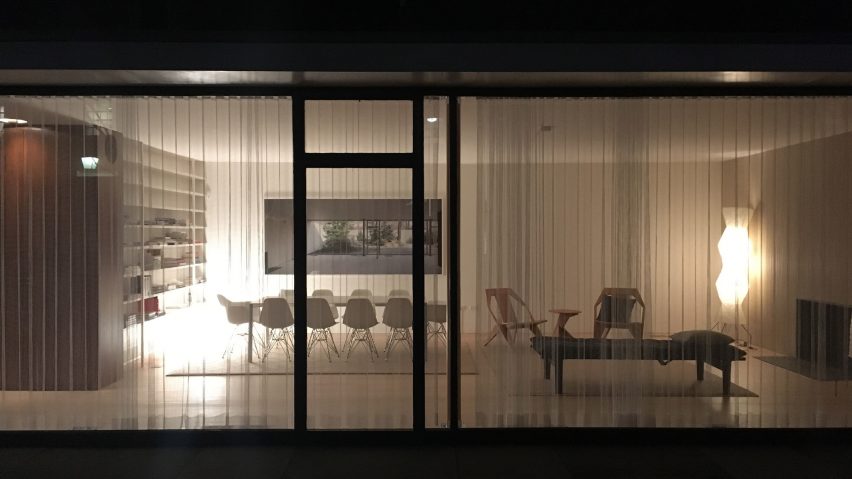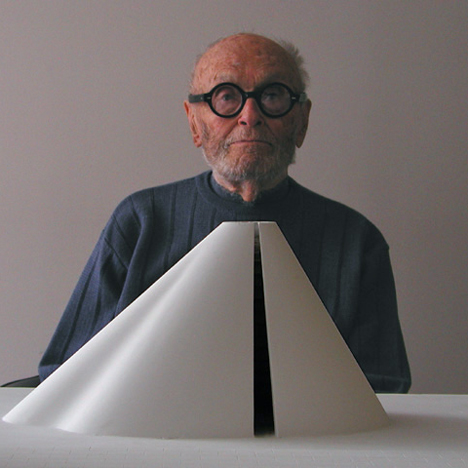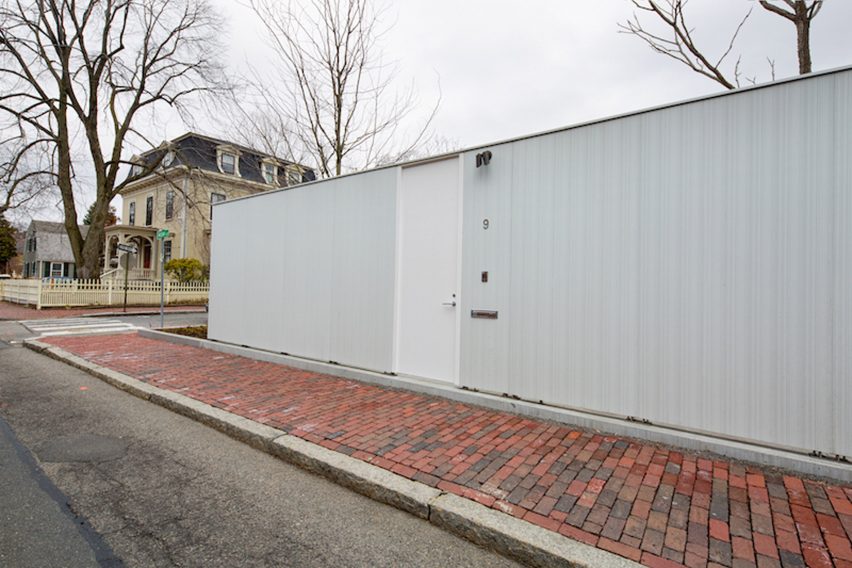
Philip Johnson's first building renamed amid protest over architect's "white supremacist views"
US architecture and design school Harvard GSD has removed Philip Johnson's name from a house he built while studying at the institution in response to a campaign calling for a rethink of the Nazi-supporting late architect's legacy.
Harvard Graduate School of Design announced this week it has renamed the house Johnson designed and built in the 1940s as his GSD thesis project.
Formerly known as Philip Johnson Thesis House, the single-storey dwelling is now named after its address, 9 Ash Street.
Philip Johnson is "an inappropriate namesake"
The move is a response to a campaign by activist organisation The Johnson Study Group that has also called on New York's Museum of Modern Art to remove Johnson's name from a curatorial post in light of the architect's "commitment to white supremacy".
MoMA employs a Philip Johnson Chief Curator of Architecture and Design to honour Johnson's involvement at the museum, where he funded the creation of its architecture department.
However, according to The Johnson Study Group, the architect's "significant and consequential" commitment to white supremacy meant he should no longer be celebrated by public institutions.

"We call on the Museum of Modern Art, Harvard Graduate School of Design, and any other public-facing nonprofit in the United States to remove the name of Philip Johnson from every leadership title, public space and honorific of any form," the group wrote in an open letter to MoMA and Harvard GSD.
"Philip Johnson's widely documented white supremacist views and activities make him an inappropriate namesake within any educational or cultural institution that purports to serve a wide public".
Martino Stierli, the current holder of Philip Johnson Chief Curator of Architecture and Design post at MoMA, told Architectural Record that the museum was taking the "issue very seriously and extensively researching all available information".
Dezeen has contacted MoMA but is yet to receive a response.
"Strenuous support of white supremacy has absolutely no place in design"
Harvard GSD dean Sarah Whiting announced the renaming of the Cambridge house in a response to The Johnson Study Group, which is dedicated to "studying the legacy of a 20th-century white supremacist who founded the most significant modern architectural institutions in the United States".
In the letter, Whiting agreed that the architect's actions meant it was "inappropriate" for the house to bear his name.
"The power he wielded and continues to wield make it critical that not only his own work as an architect and curator continues to be reappraised, but also that the consequences and persistent legacy of his influence in shaping the field and canon of architecture continue to be scrutinised," Whiting wrote.
"His racism, his fascism, and his strenuous support of white supremacy have absolutely no place in design."
Johnson used "curatorial work as a pretense to collaborate with the German Nazi party"
Johnson was born in 1906 in Cleveland, Ohio and became one of the best-known architects of the 20th century. He was awarded the first-ever Pritzker Architecture Prize in 1979 and died in 2005.
His ties to fascism have previously been detailed in a book by American journalist Marc Wortman, which describes his growing support for the Nazis in the 1930s and efforts to import fascism to America.
Called 1941: Fighting the Shadow War, the book suggests Johnson's allegiance with the regime began when he attended a youth rally led by Adolf Hitler shortly after organising a 1932 show on the International Style at MoMA. The architect's pro-Nazi efforts soon garnered attention in the US, with Harper's Magazine listed him as a leading American Nazi in an article, and the FBI tracking his activities.

"He used his office at MoMA and his curatorial work as a pretense to collaborate with the German Nazi party, including personally translating propaganda, disseminating Nazi publications, and forming an affiliated fascist part in Louisiana," The Johnson Study Group's letter said.
"He effectively segregated the architectural collection at MoMA, where under his leadership (1933-1988) not a single work by any Black architect or designer was included in the collection," it added.
"He not only acquiesced in but added to the persistent practice of racism in the field of architecture, a legacy that continues to do harm today."
Thesis house was his first built project
The house he completed in Cambridge, Massachusetts in 1941 for his Masters of Architecture thesis was his first built project. He designed the house as a rectangular volume with a tall fence that wraps around a large outdoor courtyard. A door in the fence provides access from the street into the yard.
Johnson is said to have hosted a number of parties in the house before selling it after the Second World War. GSD purchased it in 2010 and completed a restoration project in 2016.
The call to remove the prominence of Johnson's name comes in the wake of wider calls to address systemic racism in the architecture and design industries. This followed racial unrest in the US triggered by the killing of African American George Floyd.
Protests come in wake of call to address racism in architecture
Whiting said that the removal of Johnson's name is just the start in bringing change to the "the entrenched, paradigmatic racism and white supremacy of architecture".
"We do not pretend to think our work, as a school, ends here," Whiting said. "At the GSD, we are committed to doing our part to bring much-needed, long-overdue change to the field, to a fundamental reorientation toward inclusion."
"Johnson's influence runs deep and wide, and across generations, and yet he is also just one figure among the entrenched, paradigmatic racism and white supremacy of architecture," she added.
"Undoing that legacy – of the field, not only of Johnson – is arduous and necessary, and as a school and community we are committed to seeing it through."
Read of for Whiting's full letter:
Dear Mitch and other members of the Johnson Study Group:
Thank you for this note, which I take very seriously – both as dean of the GSD and as a designer. Philip Johnson's global influence in architecture in the 20th century and his grip on the field even now, 15 years after his death, cannot be overstated.
And the power he wielded and continues to wield make it critical that not only his own work as an architect and curator continues to be reappraised, but also that the consequences and persistent legacy of his influence in shaping the field and canon of architecture continue to be scrutinized. His racism, his fascism, and his strenuous support of white supremacy have absolutely no place in design.
At Harvard, the GSD owns a private residence in Cambridge that Johnson designed and built for his thesis project at the GSD, when he attended the school in the 1940s. At the university, the house doesn't have an official name on record, although it is usually referred to as the Thesis House, or the Philip Johnson Thesis House, or some variation.
But I fully agree with your strong point about the power of institutional naming, and the integrity and legitimacy it confers. And so we are taking steps to officially recognize the house within the university as simply "9 Ash Street" – the house's physical address.
As you put it, this is a minor but clarifying step in making room for other legacies to come. I agree about this, too. We do not pretend to think our work, as a school, ends here. At the GSD, we are committed to doing our part to bring much-needed, long-overdue change to the field, to a fundamental reorientation toward inclusion. Johnson's influence runs deep and wide, and across generations, and yet he is also just one figure among the entrenched, paradigmatic racism and white supremacy of architecture.
Undoing that legacy – of the field, not only of Johnson – is arduous and necessary, and as a school and community we are committed to seeing it through.